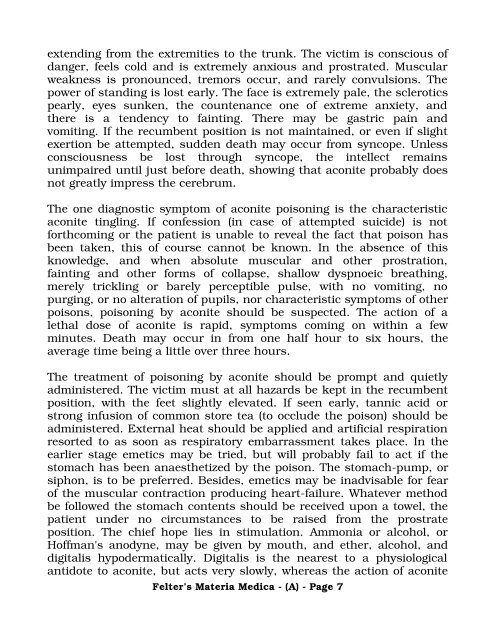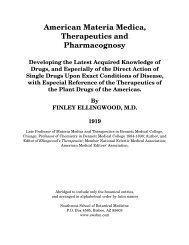Individual Drugs. ABIES (Tsuga canadensis). - Southwest School of ...
Individual Drugs. ABIES (Tsuga canadensis). - Southwest School of ...
Individual Drugs. ABIES (Tsuga canadensis). - Southwest School of ...
You also want an ePaper? Increase the reach of your titles
YUMPU automatically turns print PDFs into web optimized ePapers that Google loves.
extending from the extremities to the trunk. The victim is conscious <strong>of</strong><br />
danger, feels cold and is extremely anxious and prostrated. Muscular<br />
weakness is pronounced, tremors occur, and rarely convulsions. The<br />
power <strong>of</strong> standing is lost early. The face is extremely pale, the sclerotics<br />
pearly, eyes sunken, the countenance one <strong>of</strong> extreme anxiety, and<br />
there is a tendency to fainting. There may be gastric pain and<br />
vomiting. If the recumbent position is not maintained, or even if slight<br />
exertion be attempted, sudden death may occur from syncope. Unless<br />
consciousness be lost through syncope, the intellect remains<br />
unimpaired until just before death, showing that aconite probably does<br />
not greatly impress the cerebrum.<br />
The one diagnostic symptom <strong>of</strong> aconite poisoning is the characteristic<br />
aconite tingling. If confession (in case <strong>of</strong> attempted suicide) is not<br />
forthcoming or the patient is unable to reveal the fact that poison has<br />
been taken, this <strong>of</strong> course cannot be known. In the absence <strong>of</strong> this<br />
knowledge, and when absolute muscular and other prostration,<br />
fainting and other forms <strong>of</strong> collapse, shallow dyspnoeic breathing,<br />
merely trickling or barely perceptible pulse, with no vomiting, no<br />
purging, or no alteration <strong>of</strong> pupils, nor characteristic symptoms <strong>of</strong> other<br />
poisons, poisoning by aconite should be suspected. The action <strong>of</strong> a<br />
lethal dose <strong>of</strong> aconite is rapid, symptoms coming on within a few<br />
minutes. Death may occur in from one half hour to six hours, the<br />
average time being a little over three hours.<br />
The treatment <strong>of</strong> poisoning by aconite should be prompt and quietly<br />
administered. The victim must at all hazards be kept in the recumbent<br />
position, with the feet slightly elevated. If seen early, tannic acid or<br />
strong infusion <strong>of</strong> common store tea (to occlude the poison) should be<br />
administered. External heat should be applied and artificial respiration<br />
resorted to as soon as respiratory embarrassment takes place. In the<br />
earlier stage emetics may be tried, but will probably fail to act if the<br />
stomach has been anaesthetized by the poison. The stomach-pump, or<br />
siphon, is to be preferred. Besides, emetics may be inadvisable for fear<br />
<strong>of</strong> the muscular contraction producing heart-failure. Whatever method<br />
be followed the stomach contents should be received upon a towel, the<br />
patient under no circumstances to be raised from the prostrate<br />
position. The chief hope lies in stimulation. Ammonia or alcohol, or<br />
H<strong>of</strong>fman's anodyne, may be given by mouth, and ether, alcohol, and<br />
digitalis hypodermatically. Digitalis is the nearest to a physiological<br />
antidote to aconite, but acts very slowly, whereas the action <strong>of</strong> aconite<br />
Felter’s Materia Medica - (A) - Page 7
















